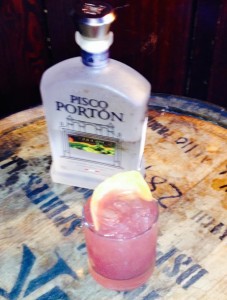The Eighty Six
- 27
- Apr
Pisco may seem a sexy (to be read, new) exotic (foreign) and obscure (uppity) spirit to both the casual drinker and the old hound as well. It however has a rich history dating to the arrival on South American shores of the first grapes to be used to make wine with the Spaniards in 1560. The story continues today and features an ongoing beef with Chile and Peru both laying claim to have distilled the spirit first.

i need a better picture.
What we know for sure is that it is a white brandy distilled from various combinations of eight approved grapes. It is distilled to proof which means it is never aged on wood, watered down or further adulterated with artificial flavors or colors (this is law for Peruvian Pisco which we are focusing on up in this beeyotch). Records as early as the 1830s show it being exported to the United States, San Francisco in particular as it was cheaper to bring up on the seas than to bring whiskey across the frontier. Punch houses were the hotness at the turn of the century in San Francisco and Duncan Nicol, who owned the Bank Exchange & Billiard Saloon which stood where the Transamerica pyramid does now, created the Pisco Punch during these days. Pisco Punch quickly gained immortality from the pens of the likes of Mark Twain, Rudyard Kipling and The New Yorker Magazine. Back then it cost twenty five cents. For real. And that was an astronomical price. The Volstead Act (booo!) killed Pisco’s popularity in the US but it held true in South America and the Pisco Sour was invented at the Morris Bar in Lima, Peru by an American, Victor V. Morris. It first appeared in print in 1946. Nowadays Pisco is growing in popularity again and both Chile and Peru have their own governing bodies to ensure the title only goes to a properly crafted spirit.
Pisco Portón (43% ABV, 86 proof) came to market in 2011 all over the map. It is distilled in Ica, Peru where the oldest distillery in the America’s dating to 1684 makes the spirit with the use of zero electricity. There is a new facility as well with more modern luxuries where Master Distiller Johnny Schuler oversees a mosto verde distilling method that is very labor intensive: about fifteen pounds of grapes are used in every bottle. Those grapes are not completely fermented in this method which keeps some of the sugars from converting to alcohol and allows more flavor for a more delicate spirit. The not-completely-fermented grapes, essentially a must or what we call grape juice are of three varieties:
- Quebranta the most popular grape used to make Pisco; gives body and a full flavor profile to the spirit.
- Albilla a grape prized for giving Pisco a smooth finish with a soft and fruity taste structure.
- Torontel a grape with a strong citrus and peach aroma; lends a heady, aromatic complexity to Pisco.
Pisco Portón is distilled to eighty six proof and ages a very slim five to eight months (law is a minimum of three) in cubas de guardia which are cement containers that won’t interact with flavor. You guessed it, a short rest in containers that won’t manipulate the hooch is law too. The result is a refreshing spirit that has great depth to be played with in cocktails. It has sniffs of hay, loose straw you’d chew on in a pair of overalls, chocolate, bananas and even a touch of mango. It does have a fine smoothness; velvety and sharp with flavors of fresh baked bread, jasmine and rose petals.
I worked at a high end Pisco bar when I first moved back to San Francisco a couple years ago. I must admit that while they dogged the shit out of me at that shop the chops exhibited there when working with Pisco were most impressive . I paid attention while I was there and learned a thing or two about a Pisco Mule and a Chilcano which helped me jump through three quick recipes before I nailed one to the wall.
The Eighty Six
1 1/2 oz Pisco Portón
3/4 oz St. Germain Elderflower Liqueur
1 oz grapefruit juice
1 oz black peppercorn rosemary syrup
1 shake black pepper
Combine all ingredients, add ice, shake for ten seconds and double strain into an old fashioned glass packed with ice. Garnish with a grapefruit twist.
*Sizzup cook one teaspoon black pepper and one sprig fresh rosemary in a pan until aromatic, then, add one cup of water and bring to a boil. Let cook for two-three minutes, strain and add an equal amount of sugar by volume, stirring till dissolved. Increase for richness as desired using a 1:1 ratio the whole way through
*don’t be lazy, use fresh juice.
A refreshing drink with herbal aromatics and a hint of spice that catches the tongue on the end will please the new or well-versed Pisco drinker. The phrase ‘eighty six’ is commonly used in the service industry (and at once the Navy too) to denote dishes/ingredients that are out of stock and where I work to say that we are done serving a customer (colloquially, ‘eighty six Ben for the night’), in this case refers to the proof the Pisco is distilled to.
